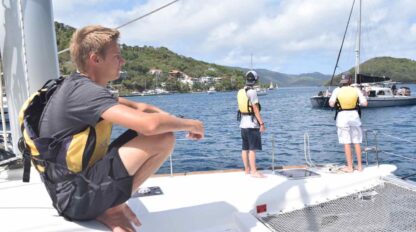Monohull vs Catamaran: Appreciating the Rivalry


If you want to really feel sailing, there’s nothing like monohulls. A lead keel extends deep into the water and keeps the boat upright. The keel allows the boat to heel (lean over on its side) in reaction to the wind’s pressure on the sails. A slight heel tends to make the boat move faster because more hull is out of the water, so there is less friction. Heeling too much can make the boat difficult to steer, but adjustments can be made. One of those adjustments is moving the crew to the windward side of the boat which can make for an exciting ride!
In comparison, a catamaran (cat for short) is considerably more stable. The two hulls keep the deck practically horizontal to the water. In fact, it’s so stable that it
is unusual for anything in the cabin to fall or shift when under sail. No need to worry about dishes left on the counter or drinks spilling. You won’t roll side to side when napping in the forward trampoline (net), but you might bounce up and down a bit.
Tacking is a sailing maneuver where you steer the bow of the boat through the wind until the sails fill with wind from the other side. This takes teamwork and timing. On our monohull sailing programs, 
The monohull draws more water than a cat. That means that the bottom of the keel reaches more feel below the waves, making navigation more interesting and challenging. When sailing a monohull, you don’t want to run aground and damage the keel. It is crucial to pay attention to the depths on the chart when planning your course. Cats don’t have keels; they just have hulls that don’t go deep at all. No worries about depth here, so you can pull up closer to shore in many locations. This is helpful when studying marine ecology on the Foxtrot and Sierra programs.

No matter which type of yacht you’re aboard, you will learn the same sailing techniques and come to appreciate the boat’s design and capabilities. There is no absolute right answer when deciding between the two as there are tradeoffs with either choice. Ready? Grab your crew. Set your sails. Permission to explore the beautiful blue is granted.


